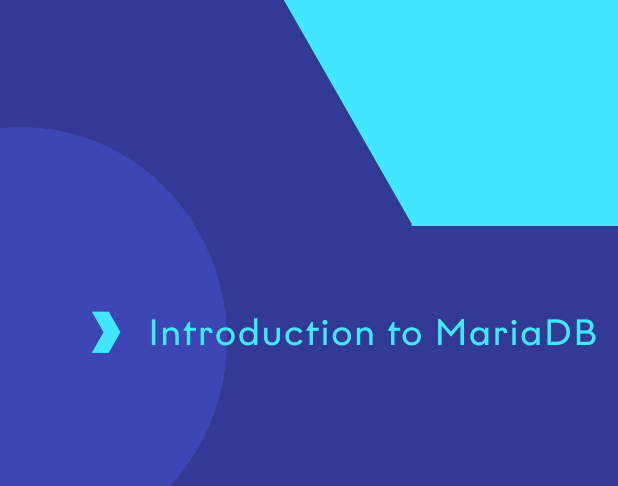Master the essentials of SQL with this practical, entry-level course. Suitable for beginners as well as those with experience of MySQL, it will help you manage and structure databases with confidence. After three days, you’ll come away with a new skillset and a toolkit to effectively work with MariaDB.
15% off eLearning, up to 20% off virtual courses - use code: EARLY1225AUS
Introduction to MariaDB
Select your learning method

Master the fundamentals of relational databases with MariaDB
This course equips you with the skills needed to work confidently with relational databases. You’ll learn database concepts, understanding how data is structured, related and stored within MariaDB; develop practical SQL skills; and cover essential data manipulation techniques.
- Use client tools to access MariaDB
- Write SQL queries to retrieve data
- Create and alter databases and tables
- Join tables and use subqueries
- Apply SQL functions and expressions
- Insert, update, delete and replace rows
- Control access with user privileges
- Import and export data securely
What you’ll learn
With our Live Labs and real-time instructor support, you’ll develop an understanding of the MariaDB environment and core SQL principles. Build a toolkit of knowledge and skills that will help you navigate databases with ease.
Understand core database concepts
Learn how relational databases work, focusing on how data is structured using tables, keys, and relationships. You’ll explore how primary and foreign keys ensure data integrity, and how databases fit into broader client-server environments. These core concepts will give you the knowledge needed to navigate and understand any relational database system, not just MariaDB.
Develop practical SQL skills
A focus of the course is building your ability to write and troubleshoot SQL queries. You’ll work with ‘select’ statements, learn to apply filters and sorting, and use ‘join’ to combine data from multiple tables. Also, explore subqueries and functions to perform complex data analysis.
Learn to manage and manipulate data safely
Beyond querying, you’ll gain the ability to maintain and update databases using SQL commands like ‘insert’, ‘update’, and ‘delete’. Learn how transactions help protect data integrity, especially when changes involve multiple steps or users. The course also shows you how to create and modify tables, define user access, and import or export data, giving you practical skills for everyday database administration and operations.
- Three days of instructor-led training
- Hands-on practical exercises
- Access to Live Labs
- Course materials and examples
- Expert instructors
- Flexible study options
- Post-course support documents
- Certificate of completion
Key facts
This course is for anyone new to MariaDB or moving from MySQL. Perfect for analysts, developers and IT professionals managing data.
There are no formal requirements for this course, although basic IT knowledge is helpful.
Our experienced trainers and interactive labs create a focused, practical environment – so you can put theory into practice from day one.
FAQs
This course teaches you the essential skills to understand, query, and manage relational databases using SQL. Through hands-on exercises, you’ll learn how to structure data, write effective queries, and perform updates and transactions confidently within a MariaDB environment.
What is MariaDB?
MariaDB is an open-source relational database management system (RDBMS) that originated as a community-developed fork of MySQL. It’s designed to be fast, scalable, and reliable, offering a high-performance database solution that supports a wide range of SQL features. This makes it well-suited for everything from small web applications to large-scale enterprise systems.
What are the similarities and differences between MariaDB and SQL?
MariaDB and SQL are closely related but serve different purposes. SQL (Structured Query Language) is the standard language used to query and manage data in relational databases. It’s the syntax you use to write commands like ‘select’, ‘insert’, and ‘delete’. MariaDB, on the other hand, is a database management system that uses SQL to store, retrieve, and organise data. In short, SQL is the language you use; MariaDB is one of the systems that lets you use it.
How will the Introduction to MariaDB course help my career progression?
This course builds practical skills that are essential in a wide range of tech-focused roles, from data analysis to software development and IT support. By learning how to write SQL queries, manage data, and navigate relational databases, you’ll be better equipped to handle real-world tasks that rely on clean, accurate, and well-structured data. These are high-demand skills across many industries, and gaining confidence in MariaDB gives you a competitive edge whether you’re starting out, reskilling or looking to advance.
What our customers say

“Tarn is an excellent instructor. Everything was clearly communicated. One of the best courses I have attended in recent years.”

“Course was informative and well-paced. The instructor was knowledgeable and explained the concept in a clear and well thought out manner.”
Join the half a million learners developing their skills with our training
A trusted partner to thousands of organisations worldwide
Our passionate team goes above and beyond to support customer needs
Please complete the form to ensure your quote is accurate and we will contact you soon.